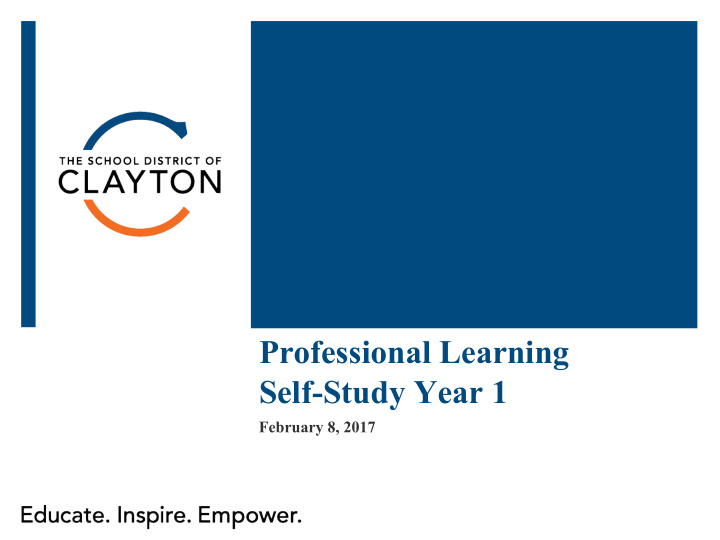



Professional Learning Self-Study Year 1 February 8, 2017
Professional Learning in Clayton is . . .
Model of Professional Learning Always See Sometimes See Never See ● Evidence of ongoing learning - what came before and what comes next ● Deepen understanding or develop awareness ● No collaboration ● Tied to District mission, School Improvement or Curricular goals ● Sit and get without opportunity of a new topic ● Teacher learning connects to students’ learning in the classroom to process or move ● Presenters from within and/or outside of ● Opportunity to offer reflection and/or evaluation ● One shot professional learning Clayton ● Differentiated learning that takes various levels of experience, ● People doing other work ● Varying opportunities to lead and learn readiness of learners and learning styles into account during professional learning ● Variety of structures for learning ● Plans are made to share learning time ○ Small group ● Data driven, tied to bigger plan ● Unbalanced dialogue ○ Whole group ● Time to interact and process ● Exclusion of job types ● Assured experiences (everyone/all staff) ● Multi-modal ● Participants who don’t know ● Just in time / pop-up learning ● Innovative the purpose ● Differentiated experiences (small groups) ● Meaningful chunks with time for processing ● Movement ● Participants who do not have ● Balance between content and pedagogical professional learning ● Content-specific learning or interdisciplinary the opportunity to share ● Balance between philosophical (theory) and practical (application) learning ● Few people present feel ● Genuine collegiality ● Responsive to staff needs in the moment connected to the topic ● Commitment to collaboration and review of norms ● Teacher choice ● Thoughts not valued ● Individual and collective growth ● Instructional strategies modeled throughout ● Fixed mindset ● Positive presuppositions toward professional learning. the professional learning ● Respectful of adult learners ● Description of learning experiences ● Time allotted for implementation for learning within the learning - communicated with parents connections to professional goals ● Opportunities to self-select content ● Evidence of learning implementation ● Topics may not always be applicable to ● Clear, specific, purposeful agenda connected to the evaluation of everyone, but everyone can share in learning - including objectives woven throughout discussion to stay in the know and share with ● Sharing the WHAT - WHY - HOW with participants others ● Setting a purpose or intention for learning ● Effective, relevant, organized ● Shared responsibility for learning - for presenting ● Participants interacting in a variety of ways - high engagement ● Topics address needs of participants (via surveys and evals) ● Motivation for immediate implementation in instruction
Discussion ◼ What do you notice about professional learning in the School District of Clayton? ◼ What questions are lingering about professional learning in the School District of Clayton?
Where We Have Been Recommendation Areas from 2012 : ◼ Accountability and Evaluation ◼ Communication ◼ Ongoing Leadership Professional Learning ◼ Subject Matter Mastery
Moving Forward 2017 Potential Areas for Examination and Growth: Calendar ◼ What amount and structure of time is needed to support professional learning for staff in the School District of Clayton? Content and School-Based Professional Learning ◼ How do we balance the needs of staff to deepen their content knowledge as well as support the identified needs of individual building improvement goals? Feedback ◼ How do we continue to make connections between staff professional learning and student learning? Best Practices in Professional Learning ◼ If we were a model for professional learning, what would our system look like?
Discussion ◼ What questions do you have or clarifications do you need about our proposed areas of examination and growth? ● Calendar ● Content and School-Based Professional Learning ● Feedback ● Best Practices in Professional Learning
Recommend
More recommend